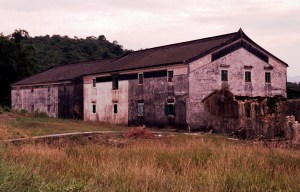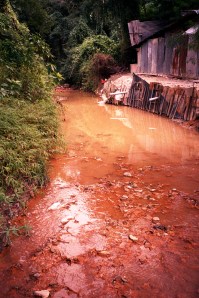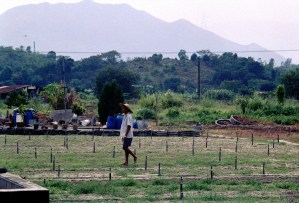Sometime around 2000, the company I worked for was struggling to find enough government work following the Asian Financial Crisis and the conclusion of the airport projects. In order to keep the wolf from the door (and the team together) one of our managers looked to the private sector, particularly property developers with deep jangly pockets. One such developer was eyeing a multiple unit development in the NENT (northeast new territories), off the western side of the Shau Tau Kok road (just south of the Luk Keng road). They were struggling to get environmental approval for their development and needed a consultant to guide them through the process.
I forget now, what the major concern was that hindered approval, but ironically, it broadly hinged around the impact of their development on an environment that was far from pristine. I object to the wholesale conversion of agricultural land to housing as much as the next tree-hugger, but my first site survey revealed that the project ought to have been turned down to protect any future inhabitants from a heavily polluted environment.
More information here about how a modern HK Landfill meets its environmental obligations.

Concluding with the entrance to NENT Landfill access road. The NENT Landfill was of huge significance to HK’s perennial fight against solid waste generation. Newly opened at the time, it was state-of-the-art guaranteed to contain smell, dust, methane and leachate (the revolting liquid that seeps to the bottom and along the most convenient watercourse).

The weighstation at the Landfill entrance. From my vantage point on an overlooking hill, I couldn’t help but notice the noise and smell of the constant procession of enclosed RCVs (refuse collection vehicles). Of course, there should be no smell from the RCVs, but despite all the PR, these brand new vehicles were leaking waste liquor all along the access road shared with local villages. When the liquor dried, it became airbourne again as dust.
From the hill, I noticed these prominent large old buildings in the middle of the valley floor.

Compared to most old NT village buildings, these are on a grand scale. Unfortunately, falling into disrepair and not likely to survive any developer’s plans for the area. If it was my development, these would be restored and at the core.

Most of the land in the valley floor however, had returned to what we call ephemeral wetland. In other words frequently flooded lowlying ground of potential ecological value.

The village of Shui Ngao Tso, separated from the landfill entrance only by the fung shui woodland – shui? that’s water isn’t it..?
A typical NT scene of the late 1990s, early 2000s, in other words. But I started to notice something was awry.
And then I came across the stream that trickled past the northern end of the village…the village that backed onto the weighstation, if you haven’t been following closely!

If you’ve ever stuck your nose over a solid waste container or skip outside a restaurant and been repelled by the odour…well that’s how this stream smelled.

Following the stream as far upstream as I could, it was obvious that the village wasn’t the source of the pollution.

You’ll perhaps recall me mentioning ‘ephemeral wetlands’? The implication of that is that this stream of pollution regularly breeches its banks and spills over all the lowlying valley floor…can I interest you in a new apartment here?
You might be thinking, “How remiss of the author not to bring this to the attention of the client and the authorities!” Of course, I did. Nobody thanked me for breaking the story. The client wanted a quick buck, not another reason to defer the development – I’d have thought they’d be glad not to get saddled with a law suit later on; the authority for the Landfill had kittens, denied any such problem existed, then warned my company about the consequences of any egg on their faces. My boss did an about face and told me to forget about the whole thing.
Tree-huggers eh, what undesirable rubbish will they dig up next!?












great story. Keep ’em coming.
Unfortunately for the environment, I can keep ’em coming!
I see what you mean about pollution.No wonder no one wants a house near the river.But the ruined houses could easily be restored. However, I guess its a case of volunteers and finance, but such a waste when people need homes.There are some similar here in Crete. Thanks for visiting my blog much appreciated.
The New Territories had a suprisingly large number of abandoned villages, many of them with very attractive traditional houses and temples. The climate isn’t kind to places like that when they aren’t maintained, sadly.